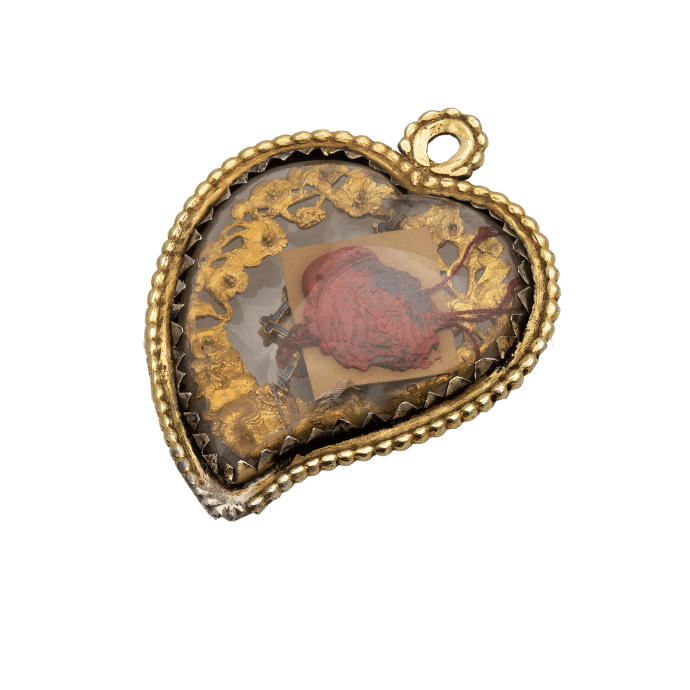


Reliquary Pendant of Saint Lawrence
, Gilded silver, silver, enamel, rock crystal, bone, paper, sealing wax

Reliquary Pendant of Saint Lawrence
Description
Double-sided silver-gilt reliquary pendant in heart shape with beaded frame and pendant loop. Separately mounted within a serrated silver frame are two convex formed rock-crystals. Visible beneath is a golden floral garland surrounding a relic bone in the center on the obverse surmounted by a blue-enameled gridiron with pearl-like ornaments, and on the reverse attached with a red cord is a paper label with ecclesiastical seal in red sealing wax. The pendant is in good wearable condition.
Literature:
For centuries relics were highly prized and authenticated by ecclesiastical seals or certificates issued by the Vatican. An ‘auténtica’, here the seal, documents the authenticity of the relic of Saint Lawrence recognizable by his attribute the gridiron.
Saint Lawrence is much venerated in Spain where he was born. He has been and continues to be the patron saint of Huesca, his city of birth in the region of Aragon. Every year the town celebrates the festival of San Lorenzo (Saint Lawrence) between the 9th and 15th of August which includes the date of his martyrdom on 10 August 258 AD. In Rome he was one of seven deacons serving under Pope Sixtus II; both were executed during the persecutions under Emperor Valerian. According to legend Saint Lawrence was burned on a gridiron, which has become his attribute, as seen here in the pendant. In honor of this important early Christian martyr, Emperor Constantine in 330 AD built over his burial place the Basilica of San Lorenzo fuori le mura, one of the main churches of Rome today. For the history of his martyrdom and iconography, see: G. Duchet-Suchaux/ M. Pastoureau, The Bible and the Saints, Paris and New York 1994, p. 213.
Historically he is highly regarded in Spain for a further reason; during the feast of Saint Lawrence the Spanish Army defeated the French in the battle of Saint Quintin (1557). To celebrate this victory, King Philip II ordered the construction of the palace and monastery of San Lorenzo del Escorial, near Madrid, with its characteristic grill shape. Philip had a great admiration for Saint Lawrence, as patron of the monastery and of peace. He gathered as many relics of this saint as he could possibly find. For a detailed account, see: Cynthia Hahn, The Reliquary Effect. Enshrining the Sacred Object, London 2017, pp. 164-170.
The flowers of the garland surrounding the relic appear to be poppies. Symbolic of the Eucharist and Christ’s passion, they represent life and death, good and evil (Marina Heilmeyer, The Language of Flowers, Symbols and Myths, Munich, London, New York 2001, pp. 58-59.
The meaning behind the relic would have been most personal to the original owner; either the saint was a namesake, or venerated for his protective qualities. He is said to be the patron saint of many professions linked to fire, cooks, glaziers, librarians and more. The choice of heart shape, much favored in Spanish devotional jewels, the poppy garland,and exquisite enameled gridiron setting is testimony to the pendant being a much-cherished treasure.